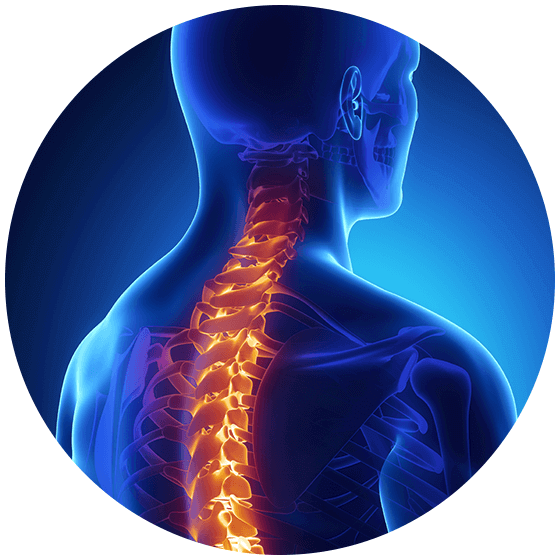Spinal Injury

Spinal Injuries Symptoms & Treatment Options
Spinal injuries occur when any of the structures that support your spine suffer unexpected injury or chronic damage. These structures include: spinal vertebrae, the spinal cord, spinal nerves, intervertebral discs, and supporting tissues (like muscles, tendons, or ligaments).
Your spinal column is the central supporting pillar of your body. It facilitates the movement of your torso, supports the skull and brain, and protects your nerve fibers. In addition, your spine provides the scaffolding that enables your rib cage to protect your internal organs.
Furthermore, composed of 33 interlocking vertebrae, your spine serves as a multifaceted shock absorber for your entire body. Your spinal discs provide an additional lubricating cushion to your vertebrae. And, a vast network of muscles and tendons provides support to your spine.
However, perhaps most importantly, your spinal column acts as a protective tunnel to encase your spinal cord. The spinal cord is the main thoroughfare across which your brain and body transmit messages. Spinal nerves branch out from the spinal cord, exiting through passageways in vertebrae to innervate all regions of the body.
Needless to say, the spine plays a crucial role in our everyday lives. This becomes especially noticeable when our backs aren’t functioning properly. In fact, back pain is a leading contributor to loss of productivity at work and missed work days. And, worse still, spinal injuries can cause you to miss out on important life events, and cause depression, anxiety, and/or insomnia.
Types of Spinal Injuries
Neck Strains & Sprains
Pinched Strains & Sprains
A common injury, neck strains & sprains occur when muscles, ligaments, or tendons in the neck endure tearing or inflammation. Car accidents, sports injuries, and failure to warm up before exercise can all cause neck strains & sprains. Additionally, symptoms can vary depending upon the extent of the damage. But, typically, warning signs will include some degree of pain or stiffness while moving the head. Many of these injuries heal without surgical intervention.
Pinched strains & sprains can occur at any location in the spine and increase in prevalence with age. When the muscles, ligaments, or tendons in the back suffer damage, this can lead to spinal instability or pinched nerves. A double whammy: inflammation and swelling from the damaged tissues can compress spinal nerves. Falls, accidents, exercise—even twisting the wrong way—can cause sprains (ligament injuries) or strains (torn tendons).
Whiplash
Spinal Cord Injury
Whiplash is a well-known term, which is most often associated with rear-end collisions. However, many people don’t realize that any sudden jerking movement of the head can cause whiplash. During a whiplash injury, the muscles, ligaments, and tendons of the neck sustain damage. Stiffness and tingling can also occur, as well as neurological symptoms such as headaches, dizziness, and fatigue. In severe cases, herniated discs or breathing problems can occur.
Of the spinal injuries, spinal cord injuries have the most potential to wreak lasting damage. Remember that your spinal cord is responsible for facilitating the brain’s communication with the rest of your body. When the spinal cord suffers an injury, partial or complete blockage of nerve signals can occur. As a result, total loss of movement, or paralysis, in the limbs can follow. Additionally, numbness, tingling, or muscular spasms can coincide.
When Spinal Injuries Are A Problem
As a matter of fact, approximately 80% of adults will experience some form of spinal injury during their lifetimes. Whether because of daily activities or sudden accidents, these injuries can result in debilitating pain and long-lasting consequences.
And, yet, it is true that many sprains will heal themselves given time and the administration of ice, heat, or NSAID medications. However, for stubborn, excruciating, or incapacitating spinal injuries, your condition will require evaluation by a qualified medical professional. A physician can help you avoid sustaining further damage to your spine and prevent a gradual worsening of your symptoms.
Both Dr. Charles Gatto and Dr. George Naseef of The Advanced Spine Center specialize in the treatment of spinal injuries. Each of these board-certified surgeons is devoted to delivering a patient-centered approach with conservative and minimally invasive options for treatment. With over 40 years of combined experience between them, you can place you trust in our clinicians to provide you with the highest standard of orthopedic care.